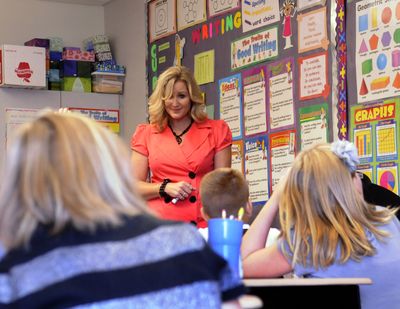A living lesson
Teacher’s vision impairment is a learning opportunity for her students

What she can do: Compete in the Wonder Woman Triathlon in Medical Lake, keep her class of fourth-graders at McDonald Elementary engaged and on task, supervise the busy schedules of her two teenagers.
What she can’t do: Read a paperback, drive a car, see the top line on a standard eye exam chart.
At age 16, Cindy Bergdahl was diagnosed with Stargardt disease, juvenile macular degeneration. “When I was 14, I started noticing I couldn’t see the chalkboard at school,” she recalled. “We lived in a remote town in Alaska with no eye doctors.”
Her vision continued to decline and the Lions Club flew her to USC Medical Center, where she received the grim diagnosis. Bergdahl said, “Counselors and vision specialists sat down and tried to tell me what my future would be. It floors me now to think how they told a teenager these devastating things.”
Stargardt disease is an inherited form of age-related macular degeneration and results in a gradual loss of vision. Bergdahl was told to forget about attending college. In fact, the list of “you can’ts” she heard far outweighed the list of “you cans.”
In her classroom at McDonald in the Central Valley School District, where she has taught for 17 years, Bergdahl said, “I’ve done a lot of things I shouldn’t have been able to do. I’ve always been pretty strong-willed.”
She shrugged off the naysayers and left Alaska to attend Eastern Washington University. Though unable to play volleyball for the school like she’d planned, she worked hard and earned a master’s degree in education in creative arts.
While in college, Bergdahl learned to handle awkward social moments that are inevitable when dealing with a disability.
“How do you tell people you can’t see? I didn’t want to be that ‘blind girl,’ ” she said. “I just wanted to blend in.”
She found her sense of humor helped ease the awkwardness and now often refers to herself as “blind chick.”
However, her visual impairment isn’t immediately noticeable. She doesn’t wear dark glasses or use a white cane. “Checkers will make comments when I struggle to use the debit machine at the grocery store,” Bergdahl said.
Each year a new crop of fourth-graders ask lots of questions. “Is your vision blurry? Is it black?” they ask.
Bergdahl has her students make a fist and put it in front of their eyes and explains, “My center vision just isn’t there, but I have good peripheral vision.”
Her 20/300 vision offers many teachable moments. “My whole focus is to relate it to things in their own lives,” she said. “I want them to respect different skills and abilities. I’m constantly saying, ‘Different is good!’ ”
While Bergdahl admits it’s difficult not being able to see her own handwriting, technology has enabled her to develop teaching strategies that work for her. She uses a magnifying device called an Aladdin to read textbooks and curriculum, and she uses an enlargement program on her computer.
When she attends her son’s baseball games or her daughter’s softball games, friends offer play-by-play commentary.
“I try to tell my husband I can’t clean house because I can’t see, but he doesn’t buy it,” she said, laughing. “He sorts the socks, though!”
She walks to work or catches a ride with family or friends. When one of those friends mentioned wanting to compete in the Wonder Woman Triathlon, Bergdahl decided to join her. After all, she’s run Bloomsday by herself.
The quarter-mile swim didn’t concern her, nor did the three-mile run, but the 11-mile bike ride did give her pause. Bergdahl said, “I won’t lie – it was scary.”
Her peripheral vision is adequate for running and swimming, but to be on a bicycle surrounded by people, and not be able to see anything in front of her, terrified her.
Once again she chose not to let fear hold her back. “It worked because I followed my friend – right on her tail – and she gave me verbal cues.”
Still, she said her heart rate was so high when she got off the bike that it actually slowed down when she started the run. Bergdahl clocked in at 1 hour and 30 minutes and plans to compete in the Wonder Woman and Valley Girl triathlons next year.
As a diversity trainer for Central Valley School District, Bergdahl has a broad platform for her message of tolerance and acceptance. “I don’t take my job for granted. I feel like I have a powerful role,” she said.
She glanced around her classroom. “My message to my kids is, you can have a disability and still be successful. I feel blessed.”